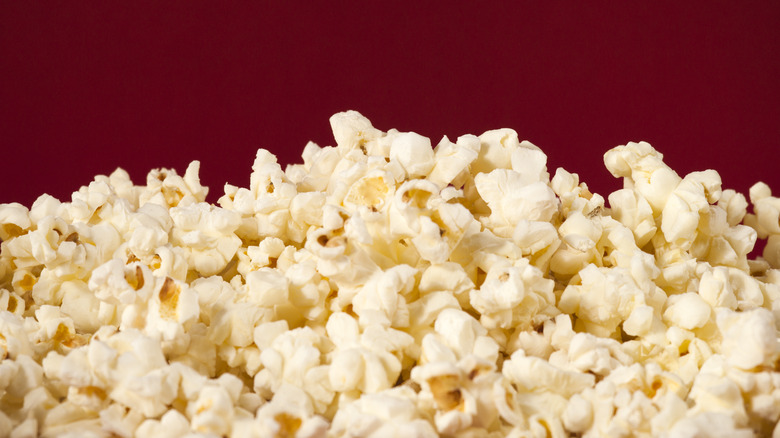Why Popcorn Can't Just Be Made From Any Type Of Corn
As snacks go, popcorn is Americans' favorite by sheer volume. It can be savory or sweet, ready to satisfy any craving, and it is widely touted for its healthy whole-grain nature. The latter trait is somewhat mitigated by the massive amounts of butter flavoring, caramel, and cheese powder that we usually dump on top of it, but come on, those seasonings are what make it so delicious. It's no wonder that human beings have been consuming popcorn for millennia. This snack's ancient history can be traced to early Mesoamerican societies. Even the act of making popcorn is fun, watching and hearing an amazing transformation take place, but it's much more complicated than you might imagine.
The only real downside to popcorn is that whenever you shovel a handful in your mouth, you run the risk of accidentally biting down on one of those hard, unpopped kernels. Ouch! It's crazy to think that the very same tender kernels we chomp off the cob could be so harsh on our teeth when they dry out ... except, that's not really the case. The yellow corn we're used to eating is completely different from the corn used for popping, which is completely different from the corn used for cornmeal, which is different from that used for corn syrup. We use the word 'corn' as an all-encompassing term, but there are multiple types, and only one of them will pop.
The 6 types of corn
There are six main varieties of corn, each serving different purposes. The corn on the cob that we enjoy as a summertime staple is technically known as sweet corn. It is harvested at a young age to keep it tender. If sweet corn were allowed to reach full maturity, its kernels would dry up and harden much like those of popcorn, but even then, it could not be used to make popcorn, as we'll explain in a moment.
The most widely-grown type of corn is neither sweet corn nor popcorn. It is known as 'dent corn' because its kernels have small indentations. Dent corn is used for making corn syrup, corn oil, biofuel, animal feed, and bourbon. Another common source of animal feed is flint corn, which you've probably seen used as Thanksgiving decor. It's also used to make foods like polenta and cornmeal. As for corn flour, it's made from the aptly-named flour corn, which is especially starchy. There's also a very rare type of corn called pod corn that grows in the wild, and it has leaves around each kernel.
But none of the corn types we've mentioned are the same as the one that puffs in the microwave. Popcorn is specifically made from popcorn — yes, that is the actual name of this particular variety. It's technically a type of flint corn, but its kernels are unique in terms of their water content, and that's where the secret to popping lies.
Why popcorn pops
The key to popcorn's poppability is in the unique structure of its kernels. Each kernel of popcorn is made up of three layers. The innermost part is the tiny germ, which is the actual living part of the plant, containing all of its genetic information. The outermost part is called the pericarp, the hull, or the bran. It's made up of cellulose, a type of carbohydrate that resides in the walls of plant cells and is the most plentiful organic material in the world. Between the germ and the pericarp is a thick layer of starch called the endosperm. What makes popcorn so unique is the fact that its endosperm layer is approximately 14% water. That may not sound like much, but it makes all the difference between the rock-hard kernels of flint corn and the fluffy popcorn we love.
The pericarp creates a highly pressurized environment within the popcorn kernel, so when you add heat to the equation, the water within the endocarp quickly boils and turns to steam. As that steam fills the inside of the kernel, it pushes outward against the hull and softens the starchy part of the endocarp. Eventually, the pressure eclipses the strength of the pericarp and the hull of the kernel bursts. The softened starch explodes and quickly turns solid. No other type of corn has the right balance of starch and moisture for this to happen.


